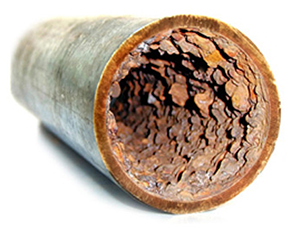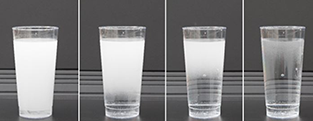Jump to topic
Water pressure, appearance and colour
We work hard to provide the best quality water to our customers. On very rare occasions you may have an issue with your drinking water, such as low pressure, discolouration, or a different smell. Before you contact us, you can read the information below as it may help solve the issue you are having with your drinking water.
You can also see our Customer Charter for more information on water pressure and quality.
Why does my water look brown?
Customers served by treated water should have water that looks clean and is consistent in quality. Water may become discoloured from sediment after a water main breaks or from corroding pipes. We undertake regular maintenance and flushing programs in all of our systems to manage sediment build up.
Your private water lines may also need to be flushed if discolouration is a problem. This can be done by running your taps on a high flow rate for a short period.
If water at your front tap (closest to the water meter) is clear, but other taps on your property have a discolouration or sediment, it's likely that galvanised piping in your home is rusting internally and causing the problem.
Generally, the rusted piping will also give the water an unpleasant taste, particularly in tea and coffee, and could also lead to a reduction in your property's water pressure and flow. This is due to the fittings and pipes becoming choked with rust flakes and particles. Rusted galvanised piping can also leave stains on washing.
You should seek advice from a licensed plumber if you think your household plumbing could be the cause of any issues you are experiencing. They can advise you on flushing your lines and replacing old pipes with new, alternative material pipes.

Why does my water look white or cloudy?
White water (milky or cloudy appearance) is due to harmless, tiny air bubbles being dispersed through the water. This can occur when air is trapped in the pipes after repair works. The problem generally goes away by itself in a short time period, or may require the water main to be flushed.
To check if air is in the water supply, fill a glass with water and allow it to stand for a few minutes. The cloudy appearance should clear from the bottom of the glass upwards. In order to alleviate the problem, run the front garden tap for a few minutes. If the problem doesn't clear, please contact us.

Why does my water taste or smell like chlorine?
Chlorination is an essential part of the process for delivering safe quality water. You can read more about this in the Australian Drinking Water Guidelines.
You may occasionally notice a chlorine taste or odour in your water. Small amounts of chlorine are added to the water as a disinfectant to destroy any waterborne, disease-causing micro-organisms (such as pathogens and infectious bacteria). This ensures that the water remains safe to drink right up until it reaches your tap.
The taste and odour of chlorine can vary with seasonal water demands and the location of your property in relation to the disinfection plant.
Some customers prefer not to drink water if they can smell chlorine. You can easily and safely remove chlorine from your water by filling a jug with water and putting it in your fridge (out of direct sunlight). The chlorine will naturally dissipate from the water.
Drinking water used in aquariums will require treatment to neutralise the chlorine and adjust other water parameters. Please consult your aquarium supplier for advice on what's required before adding drinking water to your aquarium.
Why is my water pressure low?
If you've noticed that your water pressure has changed, planned or emergency works in your local area could be the cause. Normal water pressure will be restored when the work is complete.
If your pressure is regularly low there may be other causes.
Under our Customer Charter, most residential properties should have a minimum flow rate of 20 litres per minute. You can check if the problem is occurring on your property by taking the Bucket Test:
- Make sure the stop tap located at your water meter assembly is fully open.
- Using a 5 litre bucket or container, open the tap closest to the water meter and time how long it takes to fill up the bucket;
- If it fills in 15 seconds, this indicates that the water pressure to your property is within our approved service standards. If other taps on your property do not have the same flow, there may be an issue with the plumbing on your property. You may need to engage a licensed plumber to look further into what is causing the problem.
- If it does not fill in 15 seconds, this indicates there may be an issue with the pressure of the water supply coming into your property (before the water meter) and you need to contact us.
